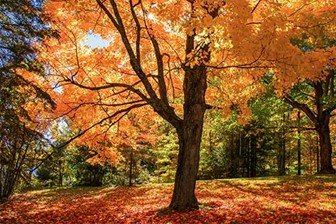Each year at the beginning of March, the Forest Preserve District of Kane County hosts two Maple Sugaring Days at LeRoy Oakes Forest Preserve in St. Charles. The event draws over a thousand people to the preserve to learn about the maple tree tapping process and how to turn sap into syrup—and to sample delicious maple treats. The Durant-Peterson House and Sholes School Museums also demonstrate traditional processing methods and share historic maple treats . Also at the museums, you can get sugar maple seeds to plant in your own yard!
Growing Zones: 4 to 7
Germination Probability: 30-50%
Stratification Requirement: 90-120 days of cold moist stratification required
The sugar maple tree, scientifically known as Acer saccharum, is a deciduous tree native to the eastern United States and Canada. Sugar maples are medium to large trees that can reach heights of 80 feet. Sugar maples thrive in well-drained soils and are commonly found in dense hardwood forests, as they can tolerate shade and grow alongside trees that block some of the sunlight. Sugar maple trees are also often grown in towns, cities, and yards.
Sugar maple trees are well-known for their hardwood, the wonderful shade they provide, and their vibrant fall foliage. The leaves turn shades of red, orange, and yellow, creating a stunning display. And of course, sugar maples are known for their sap, which is tapped in late winter or early spring and used to produce maple syrup.
Nature’s Way . . .
Maple tree seeds fall and naturally go through a process called cold moist stratification. The seeds fall to the ground, are covered by leaves falling from the trees, and are then covered even more with winter snow. The seeds spend winter in hibernation. Once spring comes and the temperatures are no longer freezing, the seeds know it is safe to sprout and grow into a tree seedling. The growing season for sugar maple seeds is May to October. During those months, the seedlings will grow and gain strength to survive the following winter.
If you pre-purchase tickets for Maple Sugar Days on Saturday, March 2 or Sunday, March 3 at the Durant-Peterson House Museum, you will receive sugar maple seeds to grow your own sugar maple tree! Click here to purchase tickets. Because you will be getting your tree seeds in March, you will have to imitate nature’s way and cold moist stratify your seeds in your fridge. Since it is cold inside your fridge, the tree seeds will think it is winter. Once you take your seeds out of the “fake winter” conditions, they will be ready to sprout/germinate under spring-like conditions.
How to Cold Moist Stratify Sugar Maple Tree Seeds
Supplies you will need:
Ziplock bags (Quart size will work).
Seed Starting Mix (Jiffy Seed Starting Mix or Miracle Grow Seed Starting Mix will work. Sold at most garden centers and big box stores).
Sugar maple seeds
Water
Bottom shelf of refrigerator (Do not use freezer).
Sugar maple seeds
Instructions:
1. Fill the ziplock bag halfway full of seed starting mix.
2. Add enough water to make the seed mix moist. You don't want leftover water gathering at the bottom of the bag. Just enough to keep the soil mix moist. Too much moisture will prevent seeds from sprouting.
3. Sprinkle your sugar maple seeds into the bag.
4. Gently shake the closed bag to cover the seeds with the moist soil mix.
5. Place the bag on a lower shelf of your fridge for 90 days.
6. Check seeds every 2 weeks to make sure no mold has grown. If moldy, too much water was added.
7. After 90 days, take the bag out of your fridge and begin the planting process. You can plant the tree indoors or you can plant it outdoors if you do not expect below-freezing weather (usually late May in most areas of the US).
8. Watch it grow and dream of the day when you can tap your sugar maples for sap!
Use A Container to Grow Your Sugar Maple Saplings
You can plant your sprouted seeds anywhere in your yard that has enough space for a large tree and can be watered regularly. But, when starting from seed, it may be best to start your seeds in a container. This way you can manage the amount of water and sunlight (not too much). Then move your saplings to permanent locations in the ground a year or two after they are established. A container is also an easy way to provide extra rich soil, something else that helps speed up sugar maple growth.
Please don’t give up! Your sugar maple saplings grow at a somewhat slow rate (from less than one foot per year to up to two feet per year). A sugar maple will mature and reach its full height in 30 to 40 years.
Sugar Maple seeds are provided by Preservation Partners of the Fox Valley who purchased them from TreeSeeds.com of Vermont, sellers of Non-GMO tree seeds and shrub seeds.
Thank you for reading! If this story interested, inspired, or informed you, please consider subscribing to our monthly e-newsletter so more of these stories come right to you!
SOURCES:
Zack DeAngelis, “Full Sugar Maple Tree Growth Timeline (How to Grow it Fast),” TreeJourney.com, last updated March 2, 2023, https://treejourney.com/full-sugar-maple-tree-growth-timeline-how-to-grow-it-fast/.
“Sugar Maple Tree Seeds,” TreeSeeds.com, accessed February 26, 2024, https://treeseeds.com/tree-seeds-for-sale/ols/products/sugar-maple-tree-seeds.
“Five Interesting Facts About Sugar Maples,” County Tree Service, accessed February 26, 2024, https://www.countytreeservice.com/5-interesting-facts-about-sugar-maples.


